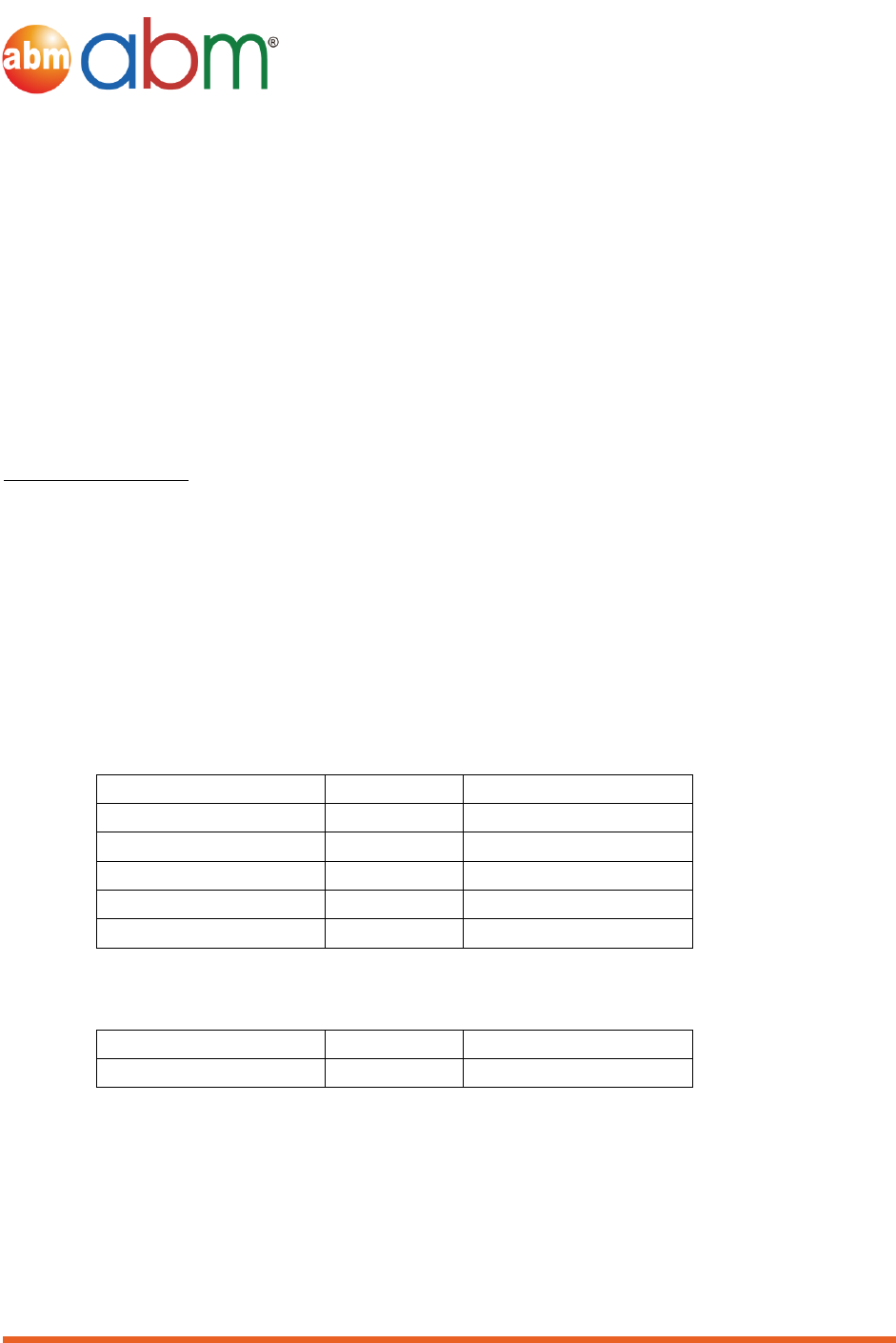
Applied Biological Materials Inc. • 1-3671 Viking Way, Richmond, BC V6V 2J5 Canada • Tel: 604-247-2416 • Fax: 604-247-2414
De-granulation (-hexosaminidase) Assay Protocol
Cat. T8156
Human Mast Cell Line (LADR)
The Human Mast Cell Line (LADR) may lose functionality after being passaged continuously for
several months (approximately after 6-12 months). Therefore, functionality testing is
recommended every 2 months.
Reagents Required:
HEPES
NaCl
KCl
Na
2
HPO
4
·7H
2
O
Glucose
PNAG (Sigma-Aldrich: N9376)
CaCl
2
·2H
2
O
MgSO
4
·7H
2
O
Citric acid
Glycine
Bovine Serum Albumin (BSA)
A. The following buffers are required:
1. HEPES buffer (1L)
Component
Amount (g)
Final Concentration
HEPES
2.38
10 mM
NaCl
8.00
137 mM
KCl
0.2
2.7 mM
Na
2
HPO
4
·7H
2
O
0.103
0.4 mM
Glucose
1.008
5.6 mM
Add H
2
O to 800 mL, adjust pH to 7.4 with NaOH (5M) and add:
CaCl
2
·2H
2
O
0.265
1.8 mM
MgSO
4
·7H
2
O
0.32
1.3 mM
Sterile filter and store at 4°C.

Applied Biological Materials Inc. • 1-3671 Viking Way, Richmond, BC V6V 2J5 Canada • Tel: 604-247-2416 • Fax: 604-247-2414
2. Citrate buffer (0.04 M, 200 mL)
Component
Amount (g)
Final Concentration
Citric acid
1.6808
0.04 M
Na
2
HPO
4
·7H
2
O
1.0723
0.02 M
Add H
2
O to 200 mL, adjust pH to 4.5 with NaOH (5M), sterile filter and store at 4°C.
3. Glycine (0.4 M, 500 mL)
Component
Amount (g)
Final Concentration
Glycine
15.1
0.4M
Add H
2
O to 500 mL, adjust pH to 10.7 with NaOH (5M), sterile filter and store at room
temperature (RT).
4. HEPES + BSA (0.04%, 100 mL)
Combine 100 mL HEPES buffer with 0.04 g BSA, sterile filter and store at 4°C.
B. Standard Procedure for β-hexosaminidase degranulation assay:
Day 1
5. Seed human mast cells at a density of 5-10x10
3
cells/well in 96 well plates. Prepare
culture in cytokine depleted medium (PriGrow X Series Medium (TM8157) + 200mM L-
Glutamine + 1% Penicillin/Streptomycin Solution) and add 100 ng/mL of fresh IgE
1
.
Incubate over night.
2
Day 2
6. Warm freshly prepared HEPES + 0.04% BSA buffer to 37°C.
7. Wash cells in HEPES + 0.04% BSA by centrifuging at 1000 rpm for 5 minutes. Repeat step
3 for a total of 3 times.
1
IgE should be spun down, if possible at 100,000xg for 30 minutes or in a microfuge at maximal speed for 30
minutes at 4°C, to eliminate aggregates. Biotinylated human IgE is recommended as it crosslinks with Streptavidin
to induce activation of the IgE receptor. If Biotinylated IgE is not available, normal human IgE can be used, and
instead of streptavidin, anti-IgE can be used to stimulate the receptor.
2
Cells are normally sensitized in one flask overnight to minimize variation in cell number between wells.

Applied Biological Materials Inc. • 1-3671 Viking Way, Richmond, BC V6V 2J5 Canada • Tel: 604-247-2416 • Fax: 604-247-2414
8. Re-suspend cells so that 90 µL equals the cell number needed for each well (total
volume is 100 µL). Aliquot cells into a flat-bottom 96 well plate and incubate for 10
minutes at 37°C
9. Prepare antigen and human stem cell factor (hSCF) solutions in HEPES + 0.04% BSA.
Make 10x dilutions.
Example Antigen titration:
Final
10x Dilution
100 ng/mL
1000 ng/mL
10 ng/mL
100 ng/mL
Add 10 µL buffer, antigen
3
, SCF
4
or antigen + SCF and incubate for 30 minutes at 37°C.
10. Meanwhile, prepare 3.5 mg/mL PNAG solution in citrate buffer – sonicate to dissolve.
Sufficient PNAG must be made for both supernatant and cell lysate (200 µL/sample).
Aliquot 100 µL/well (two 96-well flat bottom plates are required; one for supernatant
and one for lysate).
11. After incubation, spin plate at 1500 rpm for 3 minutes at 4°C.
12. Remove 50 µL of supernatant, add to 100µL PNAG, and incubate for 90 minutes at 37°C.
13. Lyse cells by adding 150 µL of 0.1% Triton X-100 (diluted in water) – pipette up/down 5
times, and transfer 50 µL of the lysis solution to the second PNAG plate and incubate for
90 minutes at 37 °C.
14. Stop reaction with 50 µL 0.4 M Glycine solution (color changes to yellow!) and read
absorbance at 405 nm with a reference filter of 620 nm.
3
The antigen is Streptavidin if biotinylated-IgE is used. Alternatively, use anti-IgE antibodies to crosslink IgE if
normal human IgE is used for cell sensitization.
4
SCF is the ligand for the c-KIT receptor which synergizes with the signaling of the IgE receptor. Normally
stimulation with SCF causes an enhanced response to IgE/antigen challenge.

Applied Biological Materials Inc. • 1-3671 Viking Way, Richmond, BC V6V 2J5 Canada • Tel: 604-247-2416 • Fax: 604-247-2414
Example Results
Optimal conditions for beta-hex release should be determined by each laboratory.
100 ng/mL biotinylated human myeloma IgE has been previously used to sensitize LAD2/LADR
cells; total release triggered by 100 ng/mL of streptavidin should range between 20-40%.
Background (control) release is usually in the range of 2% to 5%.
__
This protocol has been provided by the depositor in association with the publication: S.
Kirshenbaum, A., Yin, Y., Sundstrom, J. B., Bandara, G., & D. Metcalfe, D. (2019). Description and
characterization of a novel human mast cell line for scientific study. International Journal of
Molecular Sciences, 20(22), 5520. abm does not warrant the accuracy of such information; all
protocols must be experimentally tested by the end-user.
Updated on May 24, 2023
